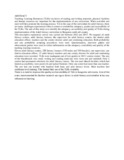| dc.description.abstract | Teaching Learning Resources (TLRs) inclusive of reading and writing materials, physical facilities and human resources are important for the implementation of any curriculum. When available and used well they promote the learning process. Yet in the case of the curriculum for adult literacy, there are many challenges experienced when it comes to availability adequacy, quality and accessibility of the TLRs. The aim of this study is to identify the adequacy, accessibility and quality of TLRs during implementation of the Adult literacy curriculum in Bungoma south sub county.
This descriptive exploratory survey was carried out between 2012 and 2013. We targeted all adult literacy centres, adult literacy learners, the supervisor for adult literacy centres, the district adult education officer, teachers and the county director adult and continuing education. Both probability and non probability sampling procedures were used. Questionnaires, interview guides and observations guides were used to collect information on the adequacy, availability and quality of the teaching learning resources.
Eleven adult literacy centres, 220 literacy learners (110 males and 110 females), one supervisor, one district education officer, 15 adult literacy teachers and one county director for adult and continuing education were recruited. TLRs were inadequate and of low quality in 10/11 centres visited. The size of the blackboards was small, writing and reading materials were worn out and outdated. Only 2 centres had permanent structures for adult literacy classes. The rest used church facilities which had limited accessibility, were poorly lit and lacked furniture. Only one center had more than one teacher. The rest had one teacher who handled both basic and post literacy levels. Most teachers had certificate level training. This limited their use of the TLRs available.
There is a need to improve the quality and accessibility of TLRs in Bungoma sub county. One of the areas recommended for further research was age a factor in adult literacy and whether it has any influence on learning. | en_US |

